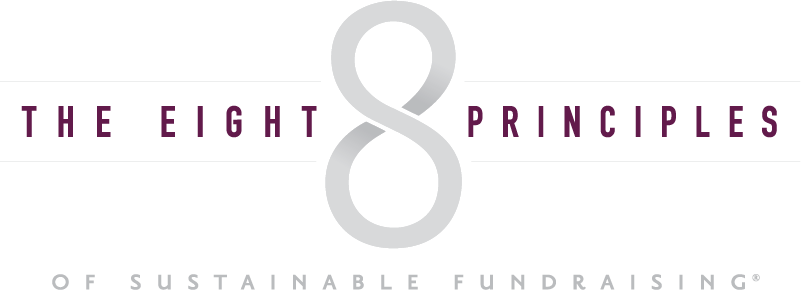In this guest post, Lisa Greer a periodic contributor to the Community Blog and author of Philanthropy Revolution, gives us point and process to implement Principle 3 of The Eight Principles®: Leadership Leads™.
In my book, Philanthropy Revolution, I include a chapter on Boards that’s called “What Money Can’t Buy: Trust, Good Governance, and Better Boards”. In it, I note that “More than once, I have walked away from charitable organizations for reasons of principle. I’ve done it even when I believed in the good work they were doing.”
So why walk away when I believed in the work?
The list of reasons is, unfortunately, quite long. Suffice it to say that it had a lot to do with issues around governance, leadership, best practices, respect, and trust. The reticence on the part of several board members to participate in any type of giving or fundraising was disturbing as well. Shouldn’t it be obvious that leaders of a nonprofit — knowing that nonprofits live or die based on funds raised — need to have an active part in fundraising? I understand that many board members bring expertise, connections, and resources, and many are very uncomfortable asking others for money. I say that as long as you have a diversified board — some members who are comfortable asking for money, and others who aren’t — that’s just fine. However, a board member who won’t even make an email introduction to a prospective donor or doesn’t see themselves as an ambassador for the organization, shouldn’t have a board seat.
In short, don’t ask or agree to serve on a board if:
- You don’t really believe in (or maybe even understand) the nonprofit’s mission
- You’re just doing so to “make friends”
- You don’t see it as a privilege to serve
- You don’t feel comfortable telling others about the organization’s goals and its good work
- You’re allergic to change
- You don’t see yourself as part of the solution to the growth and sustainability of the organization
The Harvard Business Review published a wonderful article on this about 25 years ago entitled “The New Work of the Nonprofit Board.” Sadly, the article is just as timely — and the issues just as current — as they were then. In other words, not much has changed in 25 years.
Here’s how the article begins:
Effective governance by the board of a nonprofit organization is a rare and unnatural act. Only the most uncommon of nonprofit boards functions as it should by harnessing the collective efforts of accomplished individuals to advance the institution’s mission and long-term welfare. A board’s contribution is meant to be strategic, the joint product of talented people brought together to apply their knowledge and experience to the major challenges facing the institution.
The article’s authors use the term “new work”, which they define as work that “defies the conventions that have regulated board behavior in the past.” Change! Innovation! How exciting is that?! Change and innovation in service to strengthening a nonprofit organization for the long-term, helping it to deliver greater impact than ever before? I’m “in”, as they say.
Anyone who’s served on a nonprofit board knows that there will be board members who find this “new work” to be scary, off-putting, and maybe even threatening. I was once yelled at during a formal board meeting, with a longtime board member standing up, pointing his finger at me, and yelling that I just wanted to change everything. A friend of mine told me about a board member pouring water on the head of the organization’s Executive Director because he objected to changes in the status quo.
Clearly these people need some kindness, consideration and care. However, they might not need to be on the board anymore.
One of the ways to avoid these issues is to be more careful — and, in fact, innovative — when choosing your board members.
Here are some suggestions for building a healthy, strategic, supportive, and productive board of directors:
- Look carefully and strategically at your board composition. Is your board diverse? A healthy board should incorporate a diversity of background (economic, ethnic, gender, etc.), identity, knowledge, experience, age, and even manner of speaking. Put some extra emphasis on having folks on your board who have a strong connection to your organization’s mission.
- Make sure you have some sort of term limits. Boards, where everyone has been there for 12-20+ years, can’t help but have difficulty seeing the forest through the trees. Echo chambers and boards are a bad combination.
- Make sure that your board members are respectful human beings. Screamers, bullies, and those who don’t play well with others aren’t welcome.
- Make sure your board members recognize the variety of people who make up your staff — from professionals and creatives to admin people and janitors — and that they see all of them as contributors to the organization’s success
- Make sure that your board members aren’t afraid of innovation or change. A good board member will welcome innovation and change, and if they have to understand a new technology or business model, so be it.
- Ideally, board members should not be afraid to “get their hands dirty”. A nonprofit that doesn’t let its board members volunteer is missing the point.
- Make sure that you have current by-laws, accurate and up-to-date financials, a good sense of the history of the organization and its previous successes and failures. Board members do better when they have a sense of the culture and history of the group before they even attend their first meeting.
- Ensure that you have a document with clear expectations for board members. This should not only be financial but if there is a financial requirement (“give or get” or “give and get” or otherwise), make sure it’s made clear before the board member joins the board. The financial requirement should be explicit, transparent, and equitable. Make sure that you’re not excluding diversity in favor of money — but if someone isn’t in a position to give AND refuses to help the organization raise money, they might not be a good match for your board.
These are only suggestions (although they’re based on lived experience), but are not meant to be an exhaustive list. Different organizations require different board member attributes. However, the above is a good base on which to start building (or re-building) your board of directors.
There isn’t a shortage of excellent guides, articles, and opinion pieces on nonprofit boards. Here are a few examples of ones that I have found useful:
A good, well comprised, strategic board can ultimately make or break a nonprofit institution — and donors outside of the institution are much more likely to trust an organization with a strong, well-functioning, and innovative Board of Directors. Make yours count!

Lisa Greer, lifts the lid on the charitable sector with her book, The Philanthropy Revolution: How to inspire donors, build relationships, and make a difference. Lisa is also the author of the blog, Philanthropy 451. A philanthropist with a serious interest in helping nonprofits be more responsive to their investors, Lisa lives with her husband, Josh, in Los Angeles, California.



